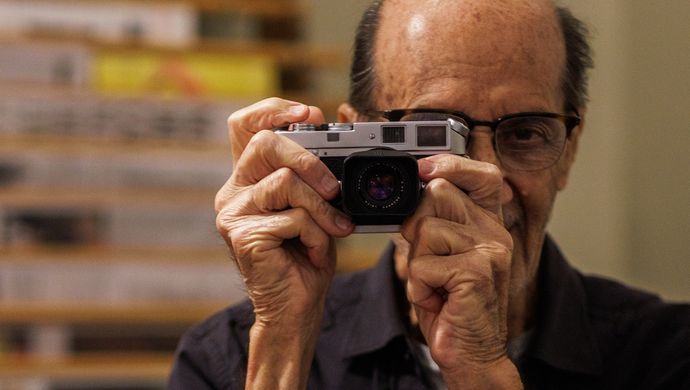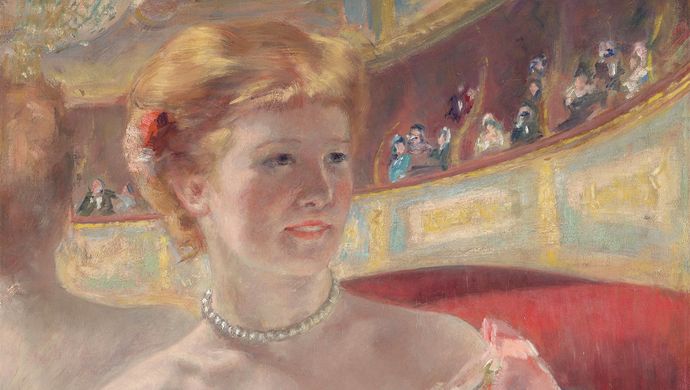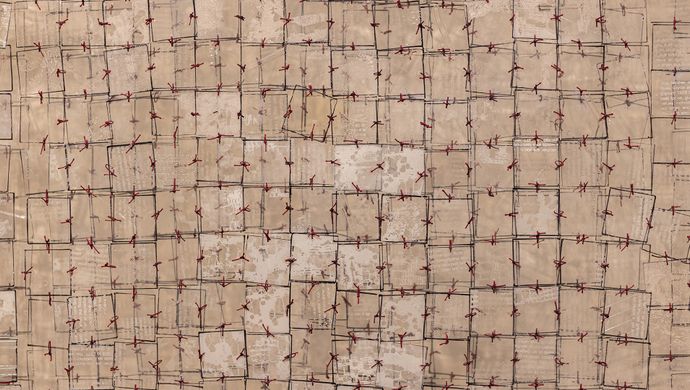 Story
Story
The cricket scrolls: HoMA’s Richard Lane Collection yields another gem
Titled A Match of Crickets in Ten Rounds of Verse and Image, they document an uta-awase—Japan’s version of a poetry slam—that was held in 1782. There are nine known existing works that chronicle this poetry event. All of them were created during the Edo period, and for a long time, it was believed that the handscroll in the Dai-tokyu Memorial Library at the Gotoh Museum in Tokyo was the original, while the other eight were copies. After two years of research on HoMA’s scrolls by University of Hawai‘i at Mānoa Dept. of East Asian Languages and Literatures faculty and students, scholars in Japan, and HoMA research associate of Japanese art Kiyoe Minami, that story has changed. In March 2022, Professor Teiko Morita of Kyoto Sangyō University, who led the collaborative research team, announced that HoMA’s scrolls are the originals. “The other eight are copies of our scrolls,” says Minami, who oversees the Lane Collection and curated Miyabi. “HoMA’s scrolls have the highest quality and are the most beautiful. The announcement at an academic conference surprised everyone and was big news in Japan.” Their appearance in Miyabi marks the first time they are on public display at HoMA. The research was conducted thanks to a grant from the Japan Society for the Promotion of Science. Now, all that work is gathered in the bilingual publication The Heian Cultural Revolution in Edo: Reading the Jūban Mishi-awase Scrolls in the Honolulu Museum of Art’s Collection. The book includes two essays by Minami and is available in the HoMA Shop.
The big clues
A range of elements clinched the identification of the Lane Collection scrolls as originals. The postscript on the works of art states: “It would be quite regrettable if people were to forget about this wonderful event, so I, Mishima Kageo, recorded it in August 1782 and made it into two volumes.” The Gotoh Museum’s version is a single scroll. In addition, painstaking research revealed that the handwritten characters on HoMA’s scrolls match those on other examples of Mishima Kageo’s work. HoMA also has the scrolls’ original wooden storage box on which Kageo wrote the title. In one painting on HoMA’s version, a waka poem is written on a green scarf, which is described in the accompanying text. This scene is missing from the Gotoh Museum’s scroll. Finally, the Gotoh Museum’s scroll is signed by the renowned artist Tanaka Totsugen, who was born in 1767, making him 16 years old when the poetry contest was held. Experts believe the artist was not capable at that age to paint such a masterpiece, and there are no records of him traveling from Kyoto to Edo that year. Because there is no artist’s signature on HoMA’s scrolls, the talent behind the painting has not yet been identified. “However, based on the style, especially in the way the pine trees are drawn, says Minami, “it is considered to have been painted by an artist following the tradition of the Tosa school, which originated from court painters.”
More on uta-awase
For uta-awase poetry matches, two teams compose waka poems (a form of classical Japanese poetry so popular it is still used today) on an assigned theme, which was often about nature. The theme for the competition illustrated in the scrolls was the chirping of crickets. Each scene on the scrolls is a poem made visual, accompanied by the judges’ comments. “Uta-awase was exclusively practiced by aristocrats during the Heian period, 794 to 1185,” says Minami, whose focus is the Lane Collection. “Female nobles were participants, but they were not allowed to sit in the same room as men.” By the time HoMA’s scrolls were painted, in 1782, people from many social classes—such as samurai, doctors, kimono merchants, as well as women—competed in uta-awase. The change in demographics reveals Japan’s social shifts from the Heian to Edo periods. In the series Shogun, now streaming on Hulu, characters communicate with lyrical lines, jointly creating their own spontaneous poems. “The sound of rain on the leaves can be heard,” Lord Toranaga says to Mariko, who responds with, “Still more fragile is the dew of tears on my sleeves even in the springtime,” building on Toranaga’s allusion to tears. The powerful samurai composes a new stanza, “Waiting, the pine tree never withers in winter,” eliciting from Mariko, “If I could use words like scattering flowers and falling leaves, what a bonfire my poems would make.” It is a symbol-laden exchange that evokes all the grace and artfulness of the era, which you can see embodied in the works on view in Miyabi. Along with the cricket scrolls are a luxurious kimono, manuals on how to apply make-up, and two sumptuous gold screens (similar works can be seen in the homes of samurai in Shogun). In the two scrolls in the exhibition, “there are other elements that evoke miyabi,” says Minami. “After researching all the waka poems and arrangements, it was found that they are inspired by court novels and poetry anthologies created by aristocrats during the Heian period, such as The Tale of Genji and Kokin Wakashū.”
The Richard Lane Collection
The Richard Lane Collection has been an acquisition that keeps on giving. Purchased from the estate of the Kyoto, Japan-based scholar Richard Lane for $26,000, what was an unorganized jumble of Asian paintings and books has been a source of exciting discoveries. In 2014, visiting scholars identified an extremely rare 16th-century Korean painting, making waves in Asian art history circles. Another find was an 18th-century calligraphy by a famous courtesan. And in 2017, curator of Japanese art Stephen Salel unearthed a rare book by Katsushika Hokusai’s daughter Katsushika Oī. The cricket scrolls are just the latest gem to emerge from the Richard Lane Collection. The public can browse book titles and artworks from the collection online.





